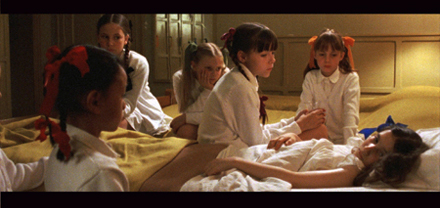|
Reviews of Recent Independent, Foreign, & Documentary Films in Theaters and DVD/Home Video
INNOCENCE
When the coffin opens, six-year-old Iris (Zoé Auclair), lying inside, blinks
her eyes and, looking at the girls surrounding her, asks for her brother.
She is told she cannot see him here and little else. Iris is the youngest of
three lead characters, prepubescent girls who question their strange and
unexplained encampment, nestled in a dense forest illuminated
by glowing chandeliers. The girls arrive there at age six and will leave at age
12, knowing little more of their exit than their entrance. Wearing age-color-coded ribbons in their hair, they are
groomed by maternal figures (servants, indentured teachers, and a
headmistress, all subordinate to a series of indistinct male figures) to
dance and to learn about nature. However, it's the girls who teach each
other how to survive in their elfin world. The governing rules and
punishments are all obediently enforced by themselves. After all, they're
taught, "Obedience is the only path to happiness." If a girl attempts to
escape and is caught, she will suffer a lifetime of servitude, or so the rumors go.
Two hours of dense symbolism alternate, at times, as engrossing, obvious,
and irritating. The movie's problem is its largest asset: the nonstop
anxiety that neither the audience nor the girls know where they are, why
they're there, who's in control, or what will happen to them. What drives
the viewer's involvement is the phantasmagoric plot, not the allegory. But
director Lucille Hadzihalilovic gives the plot no substantial resolution.
The emphasis is clearly on the symbolic.
This can make for wonderful cinema, were it not for two hours of very
fascinating questions that yield no firm answers. Innocence is almost
like a Guy Maddin film made subtle combined with a David Lynch dream-like
atmosphere, which can be very seductive to certain audiences. Conception
aside, the production shines with fantastic acting from a cast of almost
entirely inexperienced young actors and a set from Arnaud de Moleron that
embodies a child-like vision of reality. Filmed in rich colors, it's
beautiful to watch and think about, but the film struggles to balance
traditional narrative devices with very literary notions of
content and purpose. Zachary Jones
|
